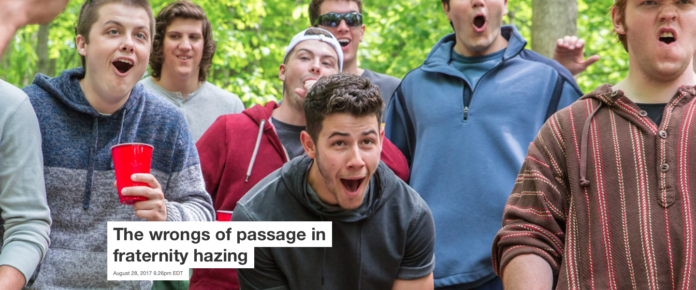
In the 40 years since publishing my first research on hazing in collegiate groups, I’ve often been reminded of the adage that every good thing is accompanied by trouble.
On the one hand, fraternities, bands and team sports provide a welcoming atmosphere for students who value the support and mentorship of older peers. They contribute to school spirit, often have members in student government and produce loyal, generous alumni after graduation.
Unfortunately, the bonding process sometimes exacts a price. Hazing has claimed the life of at least one initiate (and often more than one) every year since 1969 – the vast majority in fraternities.
The most recent incident to hit national news was the death of 19-year-old Timothy Piazza, who died from internal trauma during a pledging event sponsored by the Beta Theta Pi chapter of Penn State.

AP Photo/Chris Knight
Eighteen Beta Theta Pi brothers are facing charges related to Piazza’s death, after allegedly forcing him to drink alcohol, waiting 12 hours before calling 911 and tampering with evidence.
Prosecutors at the preliminary court hearing in Pennsylvania displayed video footage of senior chapter members prodding, photographing and ignoring the injured pledge. Jim Piazza, the victim’s father, spoke out in a “Today” show interview:
“…what happened throughout the night was just careless disregard for human life. They basically treated our son as roadkill and a rag doll.”
Penn State responds to the Piazza case
Soon after Piazza’s death, Penn State threw Beta Theta Pi off campus and boarded up its house. University President Eric J. Barron responded to the events in a recent article in USA Today, where he also described Penn State’s strict new rules for fraternities and sororities.
Among the new rules: Fraternity recruitment is now restricted to upperclassmen who have at least a 2.5 GPA, trained professionals with graduate degrees will now monitor house activities and pledging has been slashed to only six weeks.
Penn State also transferred governance from student to university oversight – a controversial move that gives the university more control over regulating Greek life on campus, but also potentially opens the school to greater liability.
The question remains: On campuses across the country, why does hazing happen in the first place? And why do incidents spiral into unintentional homicides?
Why does hazing occur?
Hazing in educational settings has been around virtually since education existed. In the fourth century, St. Augustine lamented the riotous “eversores” (translated variously from the Latin as “smashers” or “destroyers”) who preyed on new students at his school in Carthage.
Due to the “closed door” secrecy of modern initiations, legitimate hazing surveys by scholars have been few. The most commonly cited study was conducted by education researchers at the University of Maine in 2011. In a survey of 11,482 undergraduate students from 53 colleges and universities, the researchers found that 55 percent of all students involved in collegiate groups witnessed or experienced hazing.
Moreover, the study indicated that only 5 percent of the hazings were reported to college or law enforcement authorities.

Wikipedia
Anthropologist Aldo Cimino proposes an evolutionary theory for the act of hazing. He explains that veteran members of a group often wish to ensure that initiates don’t enter the organization with a free pass; the hazing rituals are a demonstration of worthiness through a series of challenges.
A second popular theory comes from sociologist Stephen Sweet, who explains the symbolic significance of hazing. At this crucial time in a young man’s life, hazing rituals and totems – such as pledge pins, paddles and even shared bottles of liquor – can all carry symbolic weight, linking pledges in their social interaction with each other.
My own theory is that fraternities exhibit cult-like behavior, sometimes with one or more “pledge educators” who restrict movements, isolate pledges from the campus community or even forbid them to speak or shower. I coined the term “Greekthink” (a play on Groupthink) that might explain why hazers exhibit negligent and dangerous behaviors, act as if members and pledges were invincible, value group practices above individual human rights and deny when abuse occurs.
And in most cases, the hazing is a never-ending cycle of reciprocity; what was done to them, they now do unto others.
The wrong rites of passage
Timothy Piazza’s hazing ritual involved consuming large amounts of alcohol in a chapter pledging requirement called “the gauntlet.” Michael Deng, a freshman at Baruch College in New York City, experienced a gauntlet of his own. He suffered a fatal blow to the head when he (and other pledges) were allegedly blindfolded and made to carry heavy backpacks while Pi Delta Psi members charged and tackled him.
Indeed, though most hazing involves alcohol consumption, requirements often include more direct physical harm. Collegians have died from accidents during drop-offs in remote locations, beatings, drownings and even gunshot wounds – all in alleged hazing incidents.
Often, defense lawyers try to convince the court that victims perform the tests willingly and, therefore, are as much participants as the hazers themselves. Piazza’s ordeal, uncharacteristically, was documented on video, showing that soon into the initiation, he seemed unable to make willing choices.

AP Photo/Mark Wallheiser, Pool
In addition to the more than 200 collegiate club or team deaths reported in the U.S. since the first hazing death occurred at Cornell in 1873, hazing is associated with numerous claimed occurrences of post-traumatic stress, hospitalizations for injuries, paralysis and scarring.
Until the late 1980s, courts tended to regard even deaths as unfortunate accidents, resulting in little or no jail time for perpetrators.
In the last 30 years, however, laws against hazing in 44 states have ruled that deaths and injuries should be regarded as crimes – not accidents. A marching band hazing death at Florida A & M in 2011 resulted in a 77-month sentence for hazing and manslaughter for one participant (who, in 2017, is appealing the conviction).

AP Photo/David Goldman
What can stop hazing?
On August 28, American University expelled 18 members of the underground fraternity chapter Epsilon Iota for various infractions, including hazing.
Although these expulsions – and felony convictions like those of hazers at Chico State – are intended as a deterrent as well as punishment, serious hazing cases at the college level continue to plague universities.
Timothy Piazza’s parents acknowledged that Penn State’s reform efforts are “a good start,” but critics question if these initiatives – and those by other universities – will be enough.
Activists, including the parents of deceased Rider University pledge Gary DeVercelly Jr., hope that proposed federal legislation may prove more effective. A bipartisan law introduced in June 2017 would require colleges to report all instances of criminal hazing and to provide all students with an educational program on hazing.
Penn State is all for it. President Barron publicly stated the university’s support for both the federal legislation and stricter state legislation. Provost Nick Jones stressed that the proposed law would help ensure “the safety and well-being of students.”
Other recommendations to curtail hazing include banning single-sex fraternities (a move now recommended by Harvard University), clear-cut and enforced university sanctions (including expulsions) and mandatory posting of hazing infractions online – a practice now employed by a handful of schools.

AP Photo/Damian Dovarganes
What’s next?
Like so many parents who have lost a child to hazing, the Piazzas say they hope Timothy’s death will serve as a clarion call to end hazing rituals.
While there have been clarion calls before, I believe this time there may be hope. Prior to the late 1920s, deaths due to freshman-sophomore class hazings surpassed deaths by fraternity hazing. A nationwide movement by students resulted in a near-end to these dangerous nonfraternity hazings, with only a single death since 1928.
Activists for groups such as HazingPrevention.org, many of them fraternity members themselves, hope a similar paradigm shift can occur today.
![]() For now, the start of a new school year is upon us, and with it comes the start of pledging. 1968 was the last year without a hazing death in the United States. Will new restrictions on campuses be enough to protect all of our students? Or will 2019-2020 become the 50th year in a row that we must mourn?
For now, the start of a new school year is upon us, and with it comes the start of pledging. 1968 was the last year without a hazing death in the United States. Will new restrictions on campuses be enough to protect all of our students? Or will 2019-2020 become the 50th year in a row that we must mourn?
Hank Nuwer, Professor of Journalism, Franklin College
This article was originally published on The Conversation. Read the original article.




















